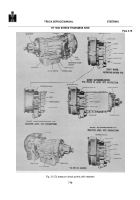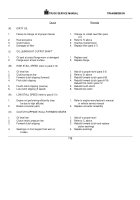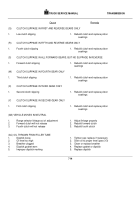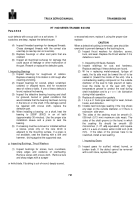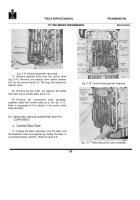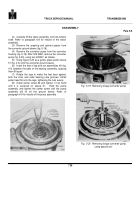TM-5-3805-254-14-P-2 - Page 727 of 894
TRUCK SERVICE MANUAL
TRANSMISSIONS
HT 700D SERIES TRANSMISSIONS
Para 4-4/4-5
4-4. CAREFUL HANDULING
During all rebuild procedures, parts and
subassemblies must be handled carefully to prevent
nicking, scratching and denting.
Parts which fit together
closely and have proper operating clearance can bind if
damaged. Parts which depend upon smooth surfaces for
sealing may leak if scratched. This is very important
concerning parts of the control valve body assembly
(valves, when dry, must move freely by their own weight).
Such parts should be carefully handled and protected
during removal, cleaning, inspection and installation as
well as being kept clean while in containers awaiting
installation.
4-5. CLEANING, INSPECTION
a. Dirt Causes Malfunction. All parts must be
clean to permit effective inspection.
At assembly, it is
very important that no dirt or foreign material be allowed
to enter the transmission.
Even minute part i c 1 e s can
cause the malfunction of close-fit parts, such as valves.
b. Cleaning Parts
(1) All the metallic parts of the transmission except
bearings and friction-faced clutch plates should
be cleaned thoroughly with volatile mineral spirits
or by the steam cleaning method. Do not use
caustic soda solution for steam cleaning. Use
only mineral spirits to clean friction-faced clutch
plates.
(2) Parts should be dried with compressed air.
Steam-cleaned
parts
should
be
oiled
immediately after drying.
(3) Clean oil passages by working a piece of soft
wire back and forth through the passages and
flushing with mineral spirits.
Dry the passages
with compressed air.
(4) Examine parts, especially oil passages, after
cleaning, to make certain they are entirely clean.
Reclean them if necessary.
c. Cleaning Bearings
(1) Bearings that have been in service should be
thoroughly washed in volatile mineral spirits.
(2) If the bearings a r e particularly dirty or filled with
hardened grease, soak them in the spirits before
trying to clean them.
(3) Before inspection, oil the bearings with the same
type of oil that will be used in the transmission.
Never dry bearings with compressed air. Do not spin
bearings while they are not lubricated.
d. Keeping Bearings Clean. Since the presence
of dirt or grit in ball bearings is usually responsible for
bearing failures, it is important to keep bearings clean
during removal and installation. Observance of the
following rules will do much to insure maximum bearing
life.
(1) Do not remove the wrapper from new bearings
until ready to install them.
(2) Do not remove the grease in which new bearings
are packed.
(3) Do not lay bearings on a dirty bench; place them
on clean, lint-free paper.
(4) If assembly is not to be completed at once, wrap
or cover the exposed bearings with clean paper
or lint-free cloth to keep out dust.
e. Inspecting Cast Parts, Machined Surfaces.
(1) Inspect bores for wear, scratches, grooves and
dirt. Remove scratches and burs with crocus
cloth. Remove foreign matter.
Replace parts
that are deeply scratched or grooved.
(2) Inspect all oil passages for obstructions. If an
obstruction is found, remove it with compressed
air, or by working a soft wire back and forth
through the passage and flushing it out with
cleaning solvent.
(3) Inspect
mounting
faces
for
nicks,
burs,
scratches,
and
foreign
matter.
Remove
720
Back to Top

